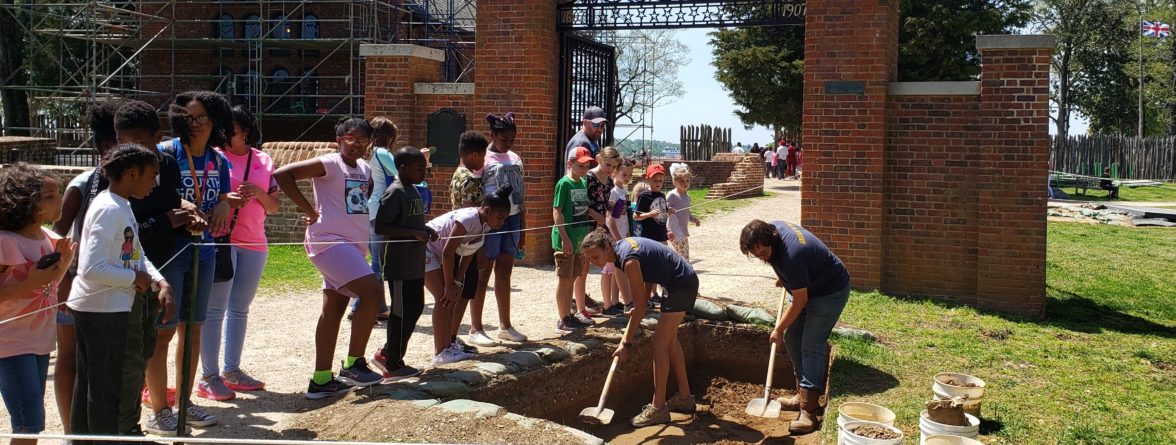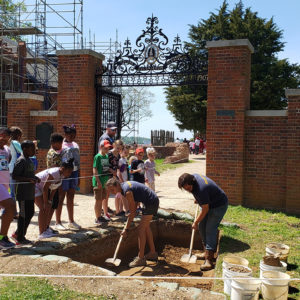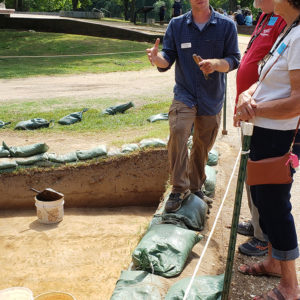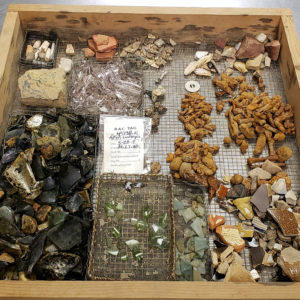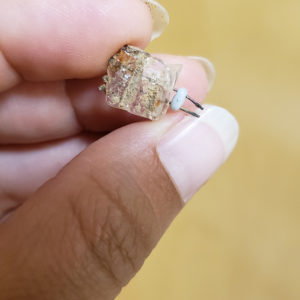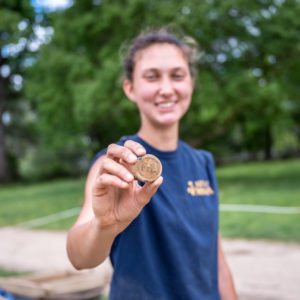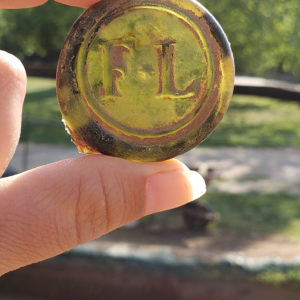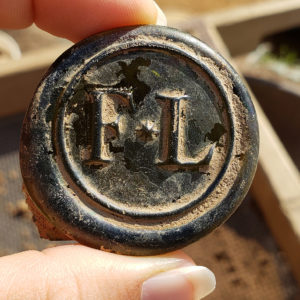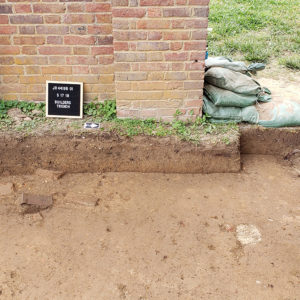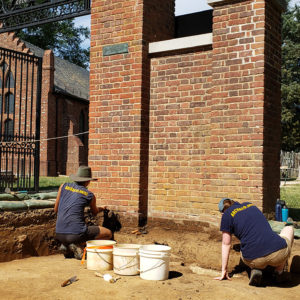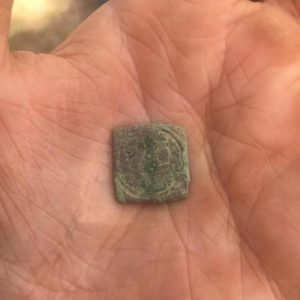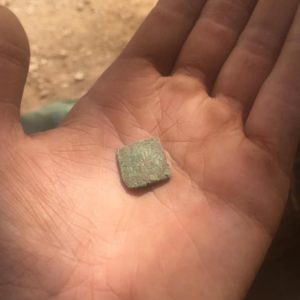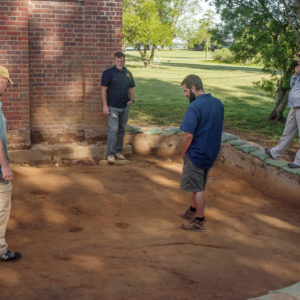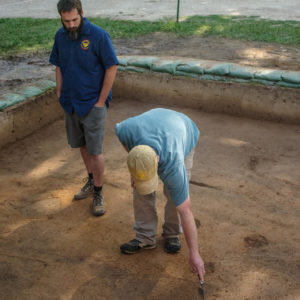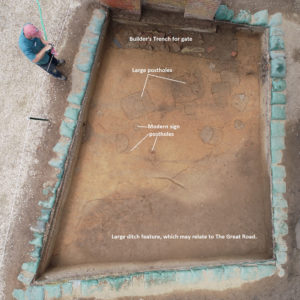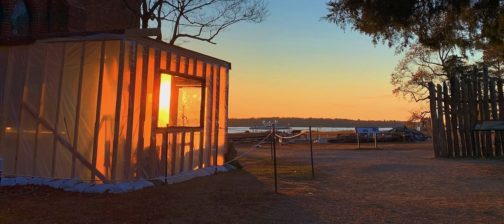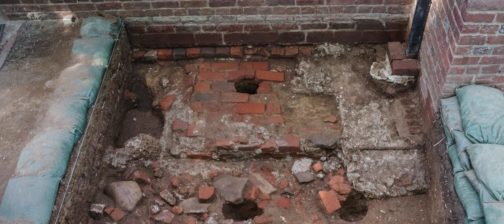Jamestown Rediscovery archaeologists spent most of May excavating in the area around the entrance gate to assist with the monument’s restoration and surrounding landscaping. Donated by the Colonial Dames of America, the gate serves as the official entrance to Preservation Virginia’s property and was long overdue for maintenance and care. Before excavations began, archaeologists conducted a ground penetrating radar (GPR) survey of the area, which showed a couple of interesting hits just east of the gate’s entrance. With this insight, they opened four test units hoping to find more evidence of James Fort’s 1608 extension and to add to our understanding of the colony’s transformation from “Fort to Port.”
As the crew removed the upper layers of gravel roadbed, artifacts recovered belonged to the period of the gate relocation in 1957 for the 350th Anniversary of Jamestown, when Queen Elizabeth II made her first visit to the site. Flash bulbs, soda can pop tops, and candy wrappers were among the many 20th century items recovered. Below this layer, they found approximately one foot of landscaping material that probably was placed there in the late 19th to early 20th centuries by the Association for the Preservation of Virginia Antiquities. Founder Mary Jeffery Galt and Jamestown Committee Chairwoman Lucy Parke Chamberlayne Bagby reported that the property was in poor condition when the APVA acquired it in 1893. In letters between the two women, they discussed how to improve the grounds through landscaping and drainage.
Senior Curator Merry Outlaw and Senior Staff Archaeologist Mary Anna R. Hartley examined artifacts from the landscaping layer and noted that the artifacts represented a wide date range. Ceramics included sherds of ubiquitous early 17th-century ware types found at Jamestown, including Midlands Purple butter pots, North Devon baluster jar, delftware drug jars, and Frechen brown stoneware Bartmann jugs. Among them were mendable fragments of objects dating to the late 19th or early 20th century. These include an Albany slip stoneware jar and a machine-made glass condiment jar, both which were probably broken and discarded around the landscaping period.
A copper alloy coin weight made in 1594 by Hans Foncq of Antwerp was among the notable objects recovered. This small artifact was used in the early 17th century to verify the weight of a gold Spanish Excelente. Its obverse bears the facing portraits of Ferdinand and Isabella, and the reverse displays the hand mark of Antwerp flanked by the date 9_4 and the initials H_F. Also recovered was a large quantity of glass wine bottle fragments dating from the 1690s to the 1770s.
Most interesting among the bottle fragments was a wine bottle seal with the initials “F*L,” believed to be those of prominent Virginian and Signer of the Declaration, Francis Lightfoot Lee. Known as Frank to his friends and associates, Lee was born in Westmoreland County in 1734, and raised at Stratford Hall. His mother, Hannah Harrison Ludwell Lee, grew up near Jamestown at Greensprings Plantation and his grandparents were buried in the Jamestown Churchyard, both before he was born. The seal may be evidence of a visit by Frank Lee to his grandparents’ graves while he served in the Virginia House of Burgesses in Williamsburg from 1765 until 1775.
Because of the location, modern postholes made up a large number of the identified features in front of the gate; they are evidence of welcome or interpretive signs that once stood at the entrance. Another modern feature found included a portion of the builder’s trench for the brick gate structure itself. However, a couple of lines of postholes uncovered belonged to earlier Jamestown periods. Resembling others found at Jamestown, two small circular postholes are likely part of property boundary fences. Two larger rectangular postholes, about two feet by 1 ½ feet wide—and possible third peeking out from the unit to the south—may be part of an earthfast structure. Glass wine bottle fragments recovered from the posthole fill provide a 1650 terminus post quem for the feature.
Before excavations, GPR data revealed faint evidence of a few postholes and a clearly visible large disturbance at the east end of the test. In this area, archaeologists uncovered what appears to be the edge of a large ditch or a series of converging ditches. Oriented north-south, the feature continues into the adjacent units. It is speculated that the ditch or ditches may be part of the “Great Roade,” which extended from Jamestown to Greensprings. On the island, the “Great Road” forked to the “Back Streete” toward the Angela Site and “the highway along the banke of the main river.” The team plans to test more of the feature as excavations continue in units to the north.
- Anna Shackelford and Les Jennings open a test unit in front of the entrance gates this May and answer questions from school groups
- Archaeologist Les Jennings leads a Jamestown Rediscovery Archaeology tour
- Senior Staff Archaeologist Sean Romo talks to visitors at the entrance gate site
- Artifacts from the Entrance Gate
- Fragment of a flash bulb
- Fragments of machine-made glass condiment jar
- Senior Curator Merry Outlaw holds one of the wine bottle necks found at the entrance gate site
- Anna Shackelford holds the wine bottle seal after its discovery
- A glass wine bottle seal with the initials “F*L”
- A glass wine bottle seal with the initials “F*L” found near the entrance gate
- Anna Shackelford points to the builder’s trench for the entrance gate. The structure was moved to this location when the National Park Service Visitor’s Center was constructed around 1957.
- Anna Shackelford and Meaghan Harrington excavate around the entrance gate
- The obverse of the coin weight bears the facing portraits of Ferdinand and Isabella
- The reverse of the coin weight displays the hand mark of Antwerp flanked by the date 9_4 and the initials H_F.
- Director of Archaeology Dave Givens discusses some of the features uncovered by the entrance gates with senior staff and supervisors.
- Sean Romo scores one of the large postholes found by the entrance gate
- Bob Chartrand, Sean Romo, and Mary Anna Hartley trowel clean the site by the entrance gate for the final photos.
- Features in front of the entrance gates


